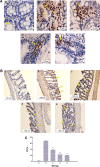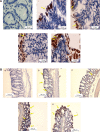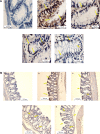The chemopreventive potential of Curcuma purpurascens rhizome in reducing azoxymethane-induced aberrant crypt foci in rats
- PMID: 26251570
- PMCID: PMC4524378
- DOI: 10.2147/DDDT.S84560
The chemopreventive potential of Curcuma purpurascens rhizome in reducing azoxymethane-induced aberrant crypt foci in rats
Abstract
Curcuma purpurascens BI. rhizome, a member of the Zingiberaceae family, is a popular spice in Indonesia that is traditionally used in assorted remedies. Dichloromethane extract of C. purpurascens BI. rhizome (DECPR) has previously been shown to have an apoptosis-inducing effect on colon cancer cells. In the present study, we examined the potential of DECPR to prevent colon cancer development in rats treated with azoxymethane (AOM) (15 mg/kg) by determining the percentage inhibition in incidence of aberrant crypt foci (ACF). Starting from the day immediately after AOM treatment, three groups of rats were orally administered once a day for 2 months either 10% Tween 20 (5 mL/kg, cancer control), DECPR (250 mg/kg, low dose), or DECPR (500 mg/kg, high dose). Meanwhile, the control group was intraperitoneally injected with 5-fluorouracil (35 mg/kg) for 5 consecutive days. After euthanizing the rats, the number of ACF was enumerated in colon tissues. Bax, Bcl-2, and proliferating cell nuclear antigen (PCNA) protein expressions were examined using immunohistochemical and Western blot analyses. Antioxidant enzymatic activity was measured in colon tissue homogenates and associated with malondialdehyde level. The percentage inhibition of ACF was 56.04% and 68.68% in the low- and high-dose DECPR-treated groups, respectively. The ACF inhibition in the treatment control group was 74.17%. Results revealed that DECPR exposure at both doses significantly decreased AOM-induced ACF formation, which was accompanied by reduced expression of PCNA. Upregulation of Bax and downregulation of Bcl-2 suggested the involvement of apoptosis in the chemopreventive effect of DECPR. In addition, the oxidative stress resulting from AOM treatment was significantly attenuated after administration of DECPR, which was shown by the elevated antioxidant enzymatic activity and reduced malondialdehyde level. Taken together, the present data clearly indicate that DECPR significantly inhibits ACF formation in AOM-treated rats and may offer protection against colon cancer development.
Keywords: PCNA; Zingiberaceae; colon cancer.
Figures







Similar articles
-
Inhibitory effect of Curcuma purpurascens BI. rhizome on HT-29 colon cancer cells through mitochondrial-dependent apoptosis pathway.BMC Complement Altern Med. 2015 Feb 5;15:15. doi: 10.1186/s12906-015-0534-6. BMC Complement Altern Med. 2015. PMID: 25652758 Free PMC article.
-
Chemoprevention of colonic aberrant crypt foci by Gynura procumbens in rats.J Ethnopharmacol. 2014 Feb 12;151(3):1194-1201. doi: 10.1016/j.jep.2013.12.044. Epub 2014 Jan 3. J Ethnopharmacol. 2014. PMID: 24393787
-
Evaluation of chemopreventive effects of Acanthus ilicifolius against azoxymethane-induced aberrant Crypt Foci in the rat colon.PLoS One. 2014 May 12;9(5):e96004. doi: 10.1371/journal.pone.0096004. eCollection 2014. PLoS One. 2014. PMID: 24819728 Free PMC article.
-
Prevention of colon cancer and modulation of aberrant crypt foci, cell proliferation, and apoptosis by retinoids and NSAIDs.Adv Exp Med Biol. 1999;470:55-63. doi: 10.1007/978-1-4615-4149-3_6. Adv Exp Med Biol. 1999. PMID: 10709674 Review.
-
Azoxymethane-induced rat aberrant crypt foci: relevance in studying chemoprevention of colon cancer.World J Gastroenterol. 2008 Nov 21;14(43):6632-5. doi: 10.3748/wjg.14.6632. World J Gastroenterol. 2008. PMID: 19034964 Free PMC article. Review.
Cited by
-
The Great Healing Potential Hidden in Plant Preparations of Antioxidant Properties: A Return to Nature?Oxid Med Cell Longev. 2020 Oct 9;2020:8163868. doi: 10.1155/2020/8163868. eCollection 2020. Oxid Med Cell Longev. 2020. PMID: 33101592 Free PMC article. Review.
-
Polysaccharides from Lentinus edodes prevent acquired drug resistance to docetaxel in prostate cancer cells by decreasing the TGF-β1 secretion of cancer-associated fibroblasts.J Nat Med. 2023 Sep;77(4):817-828. doi: 10.1007/s11418-023-01722-w. Epub 2023 Jun 24. J Nat Med. 2023. PMID: 37354258
-
Thymoquinone subdues tumor growth and potentiates the chemopreventive effect of 5-fluorouracil on the early stages of colorectal carcinogenesis in rats.Drug Des Devel Ther. 2016 Jul 11;10:2239-53. doi: 10.2147/DDDT.S109721. eCollection 2016. Drug Des Devel Ther. 2016. PMID: 27468227 Free PMC article.
-
Chemoprotective effect of arbutin on azoxymethane-induced aberrant crypt foci in rat colon via modulation of PCNA/Bax protein.Braz J Med Biol Res. 2024 Jul 1;57:e13306. doi: 10.1590/1414-431X2024e13306. eCollection 2024. Braz J Med Biol Res. 2024. PMID: 38958363 Free PMC article.
-
Combination of 5-Fluorouracil and Thymoquinone for Enhanced Cytotoxicity, Genotoxicity and Apoptosis In Colorectal Cancer: In Vitro and In Vivo Studies.J Biochem Mol Toxicol. 2025 May;39(5):e70276. doi: 10.1002/jbt.70276. J Biochem Mol Toxicol. 2025. PMID: 40304270 Free PMC article.
References
-
- Hajiaghaalipour F, Kanthimathi MS, Sanusi J, Rajarajeswaran J. White tea (Camellia sinensis) inhibits proliferation of the colon cancer cell line, HT-29, activates caspases and protects DNA of normal cells against oxidative damage. Food Chem. 2015;169:401–410. - PubMed
-
- Tenesa A, Dunlop MG. New insights into the aetiology of colorectal cancer from genome-wide association studies. Nat Rev Genet. 2009;10(6):353–358. - PubMed
-
- Rustgi AK. The genetics of hereditary colon cancer. Genes Dev. 2007;21(20):2525–2538. - PubMed
-
- Kraus S, Arber N. Inflammation and colorectal cancer. Curr Opin Pharmacol. 2009;9(4):405–410. - PubMed
Publication types
MeSH terms
Substances
LinkOut - more resources
Full Text Sources
Research Materials
Miscellaneous

